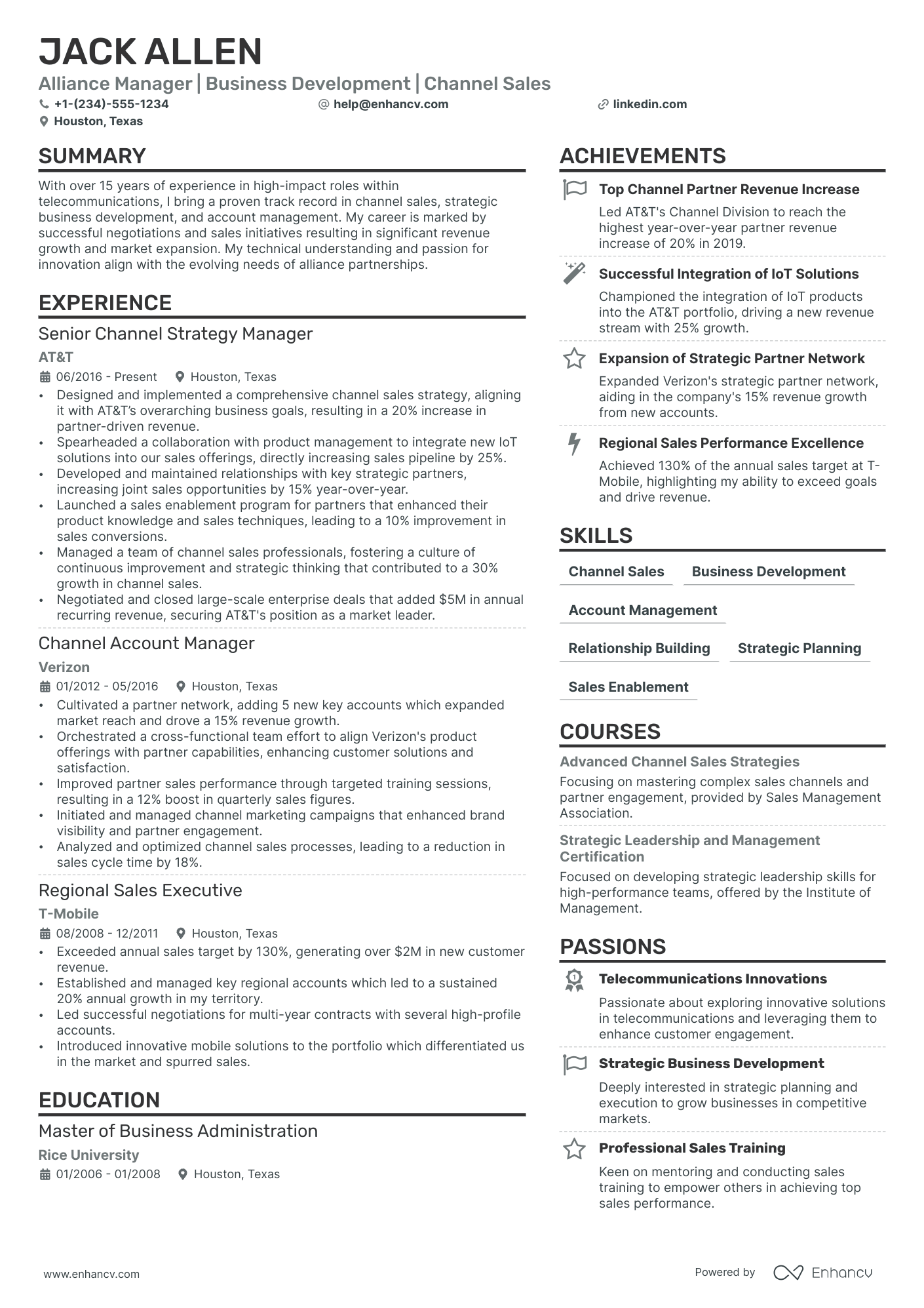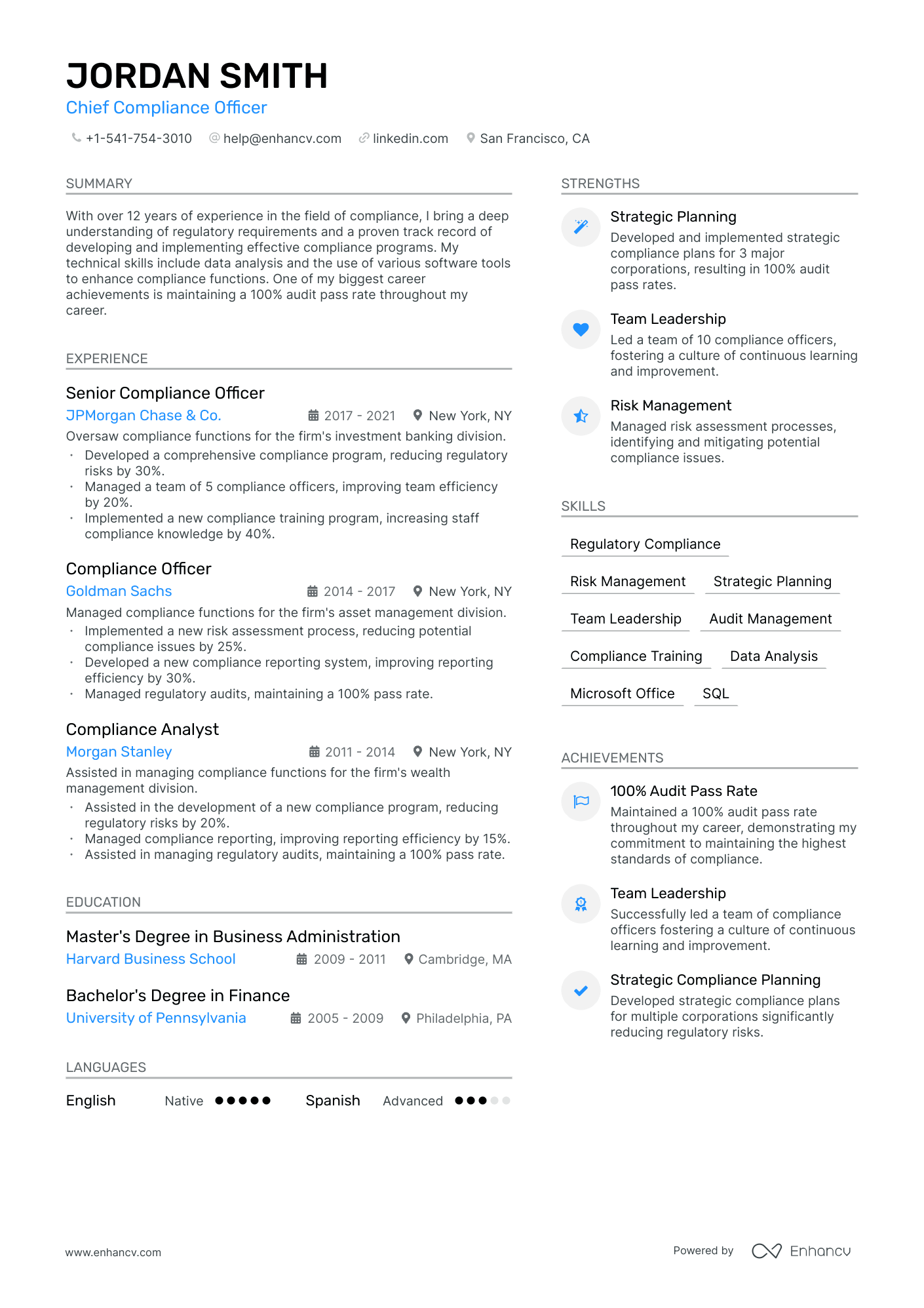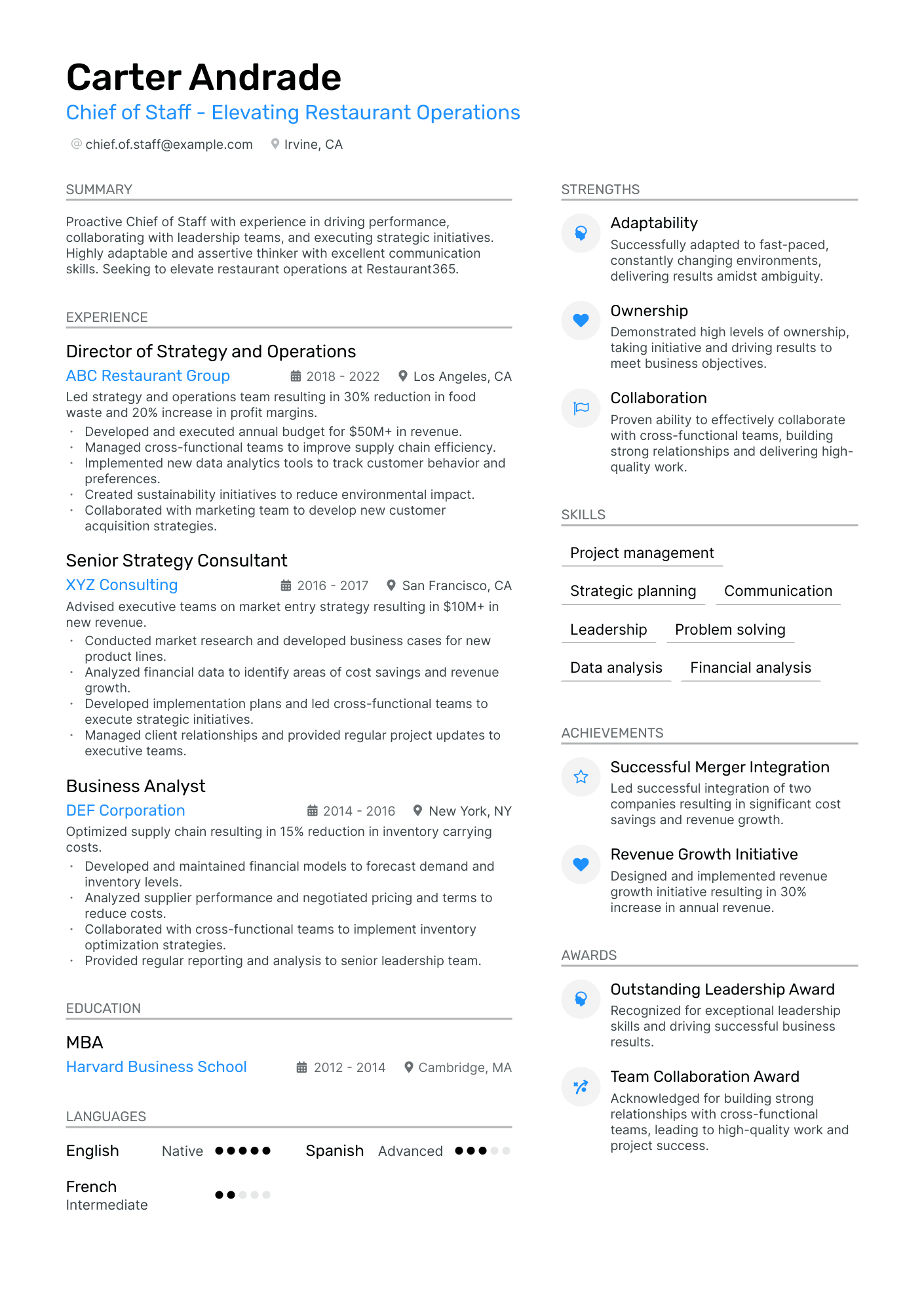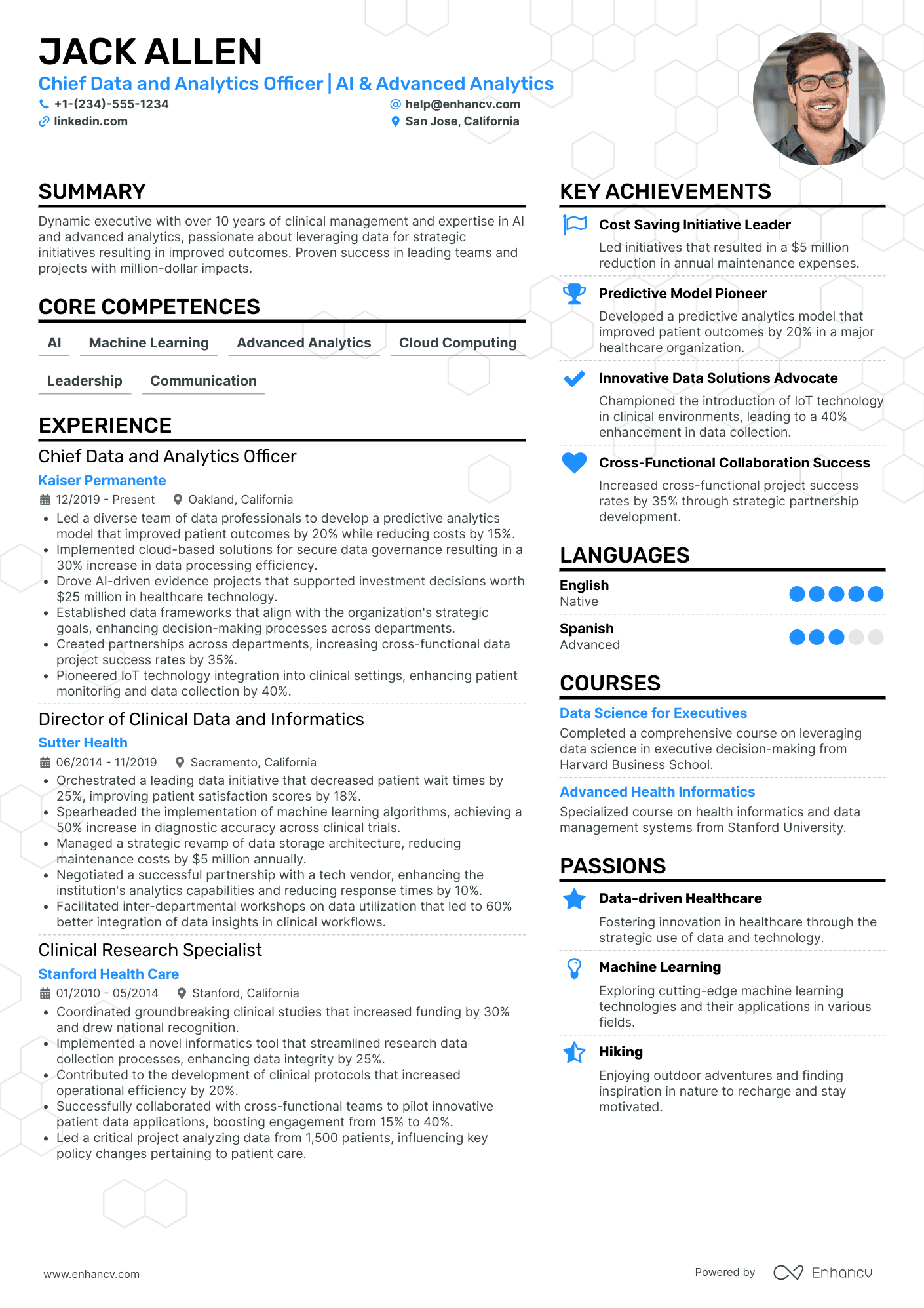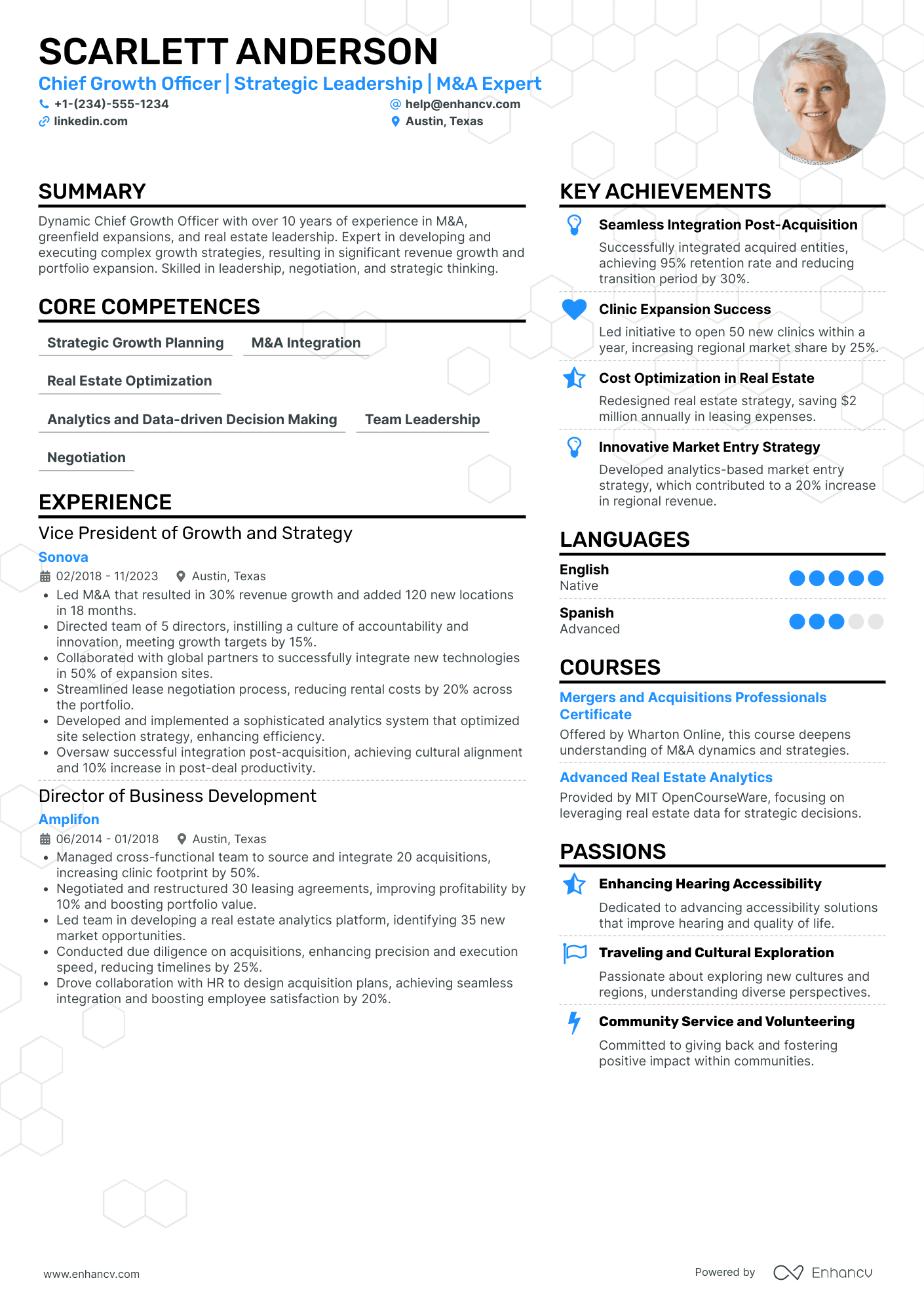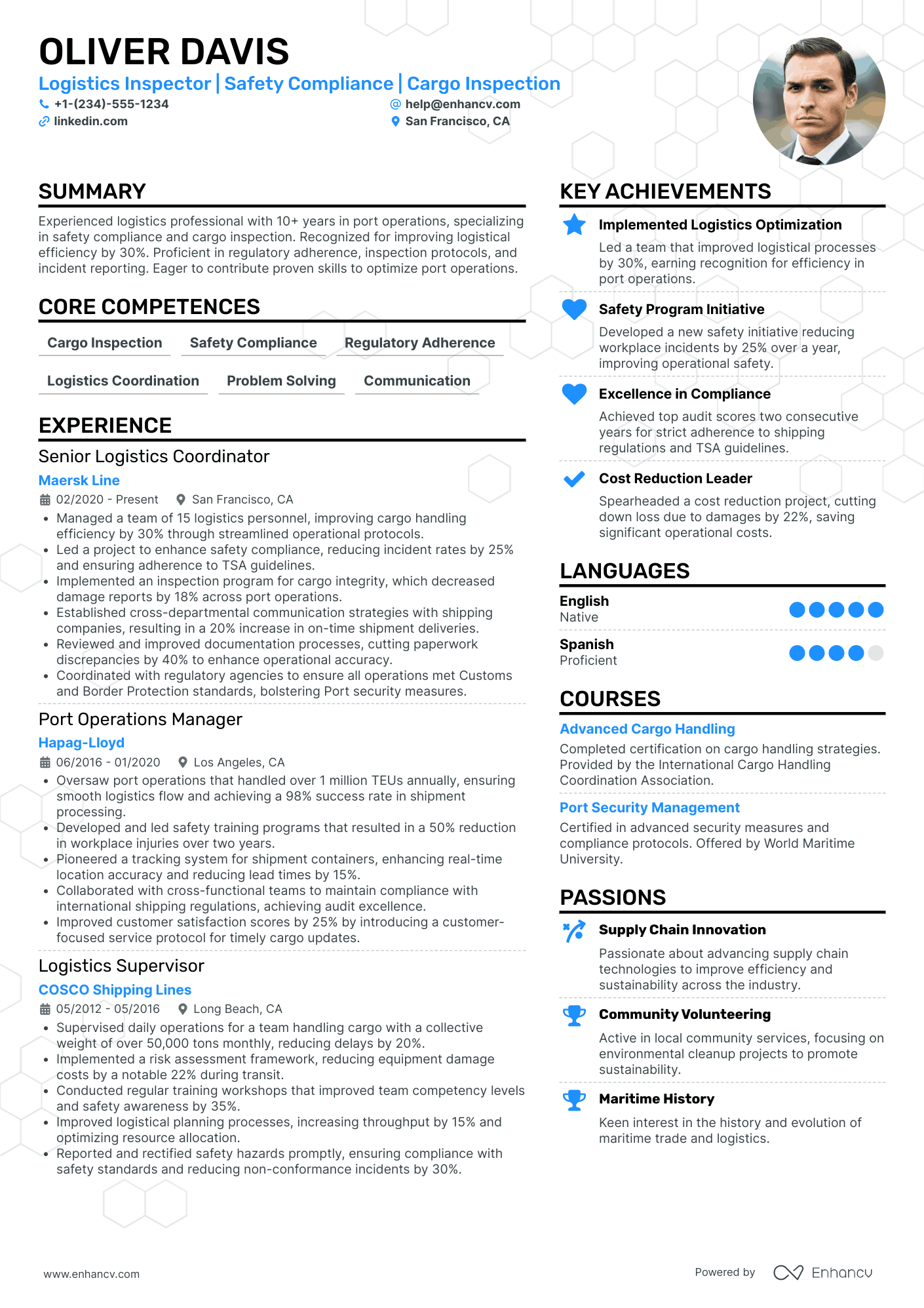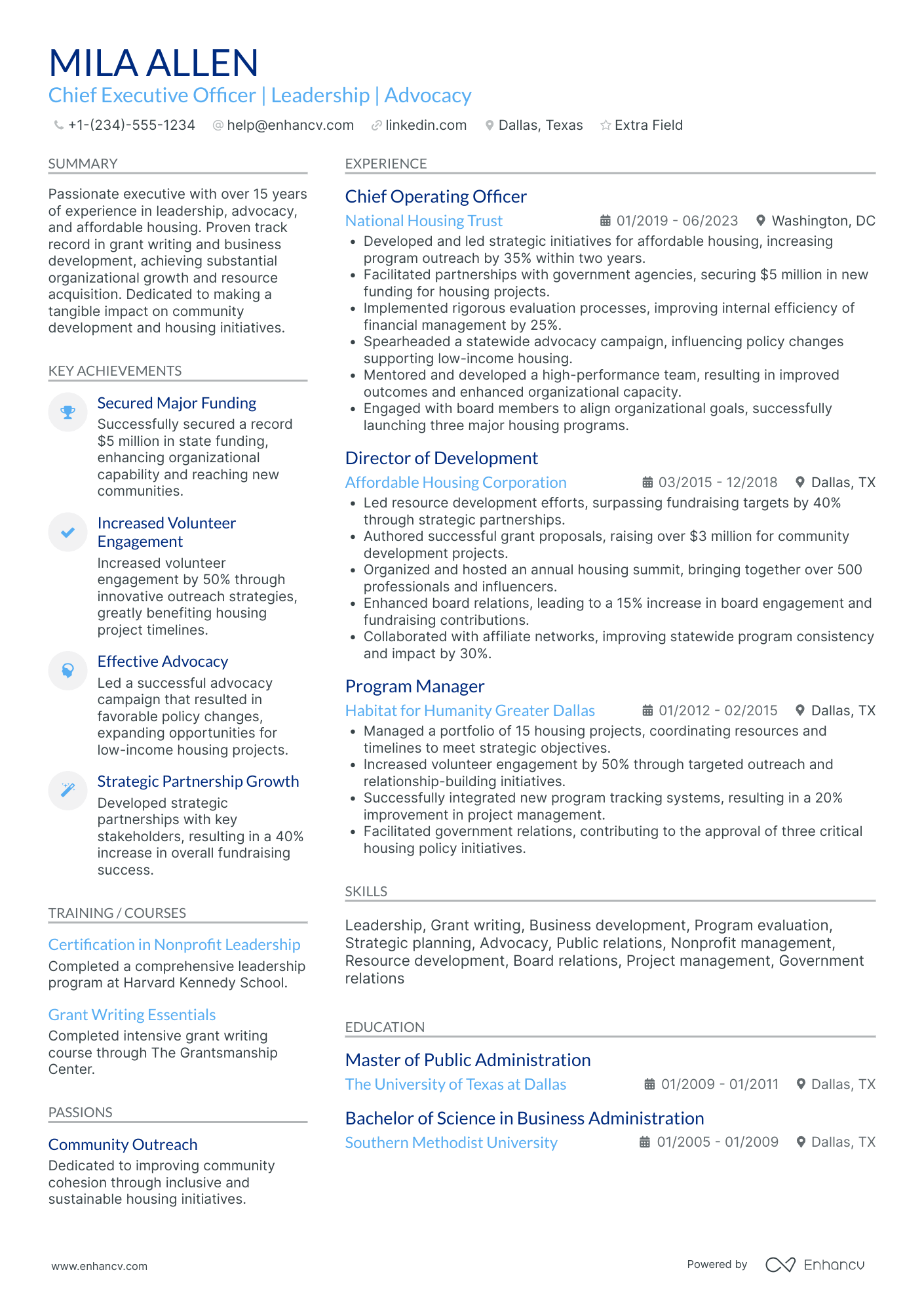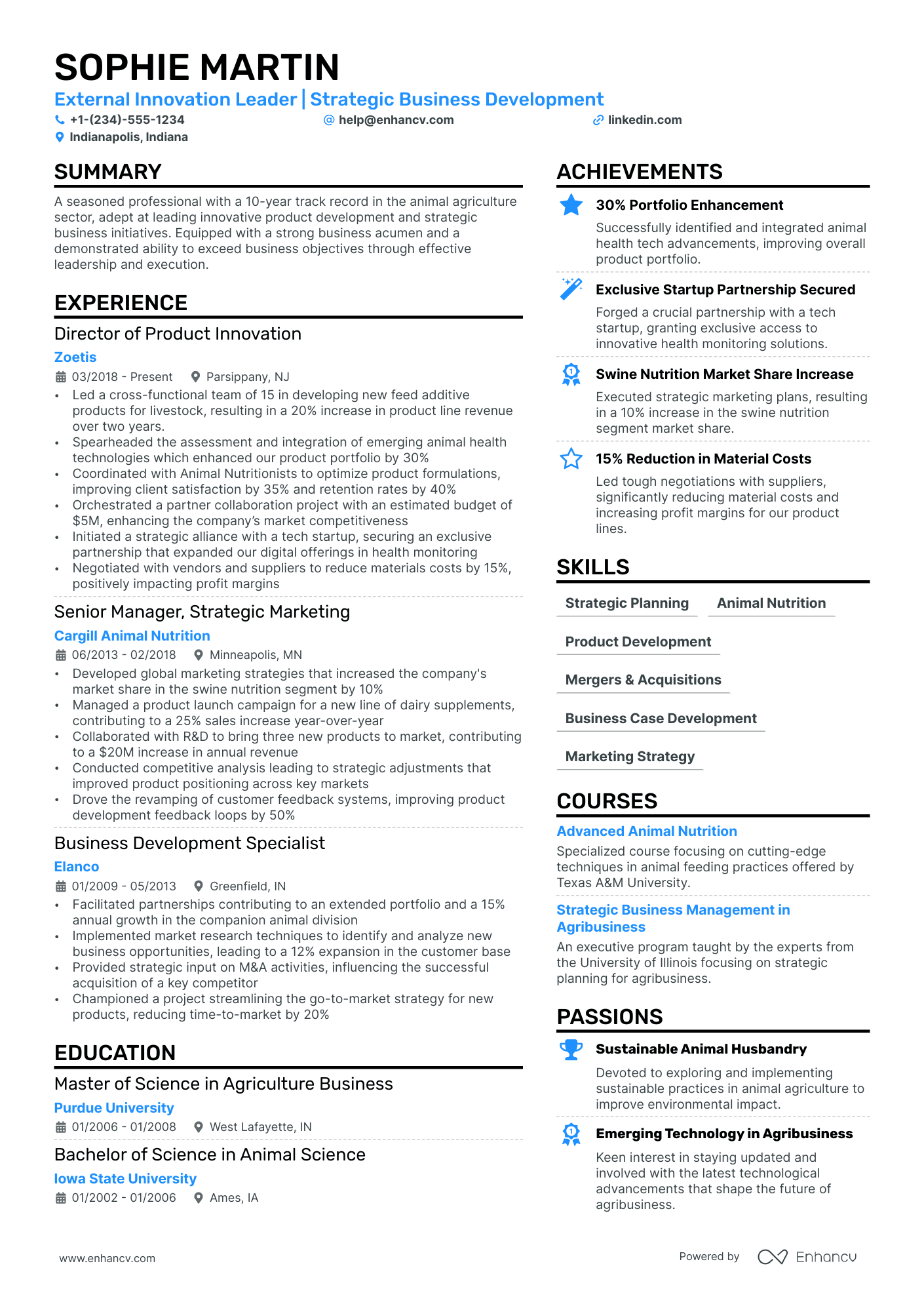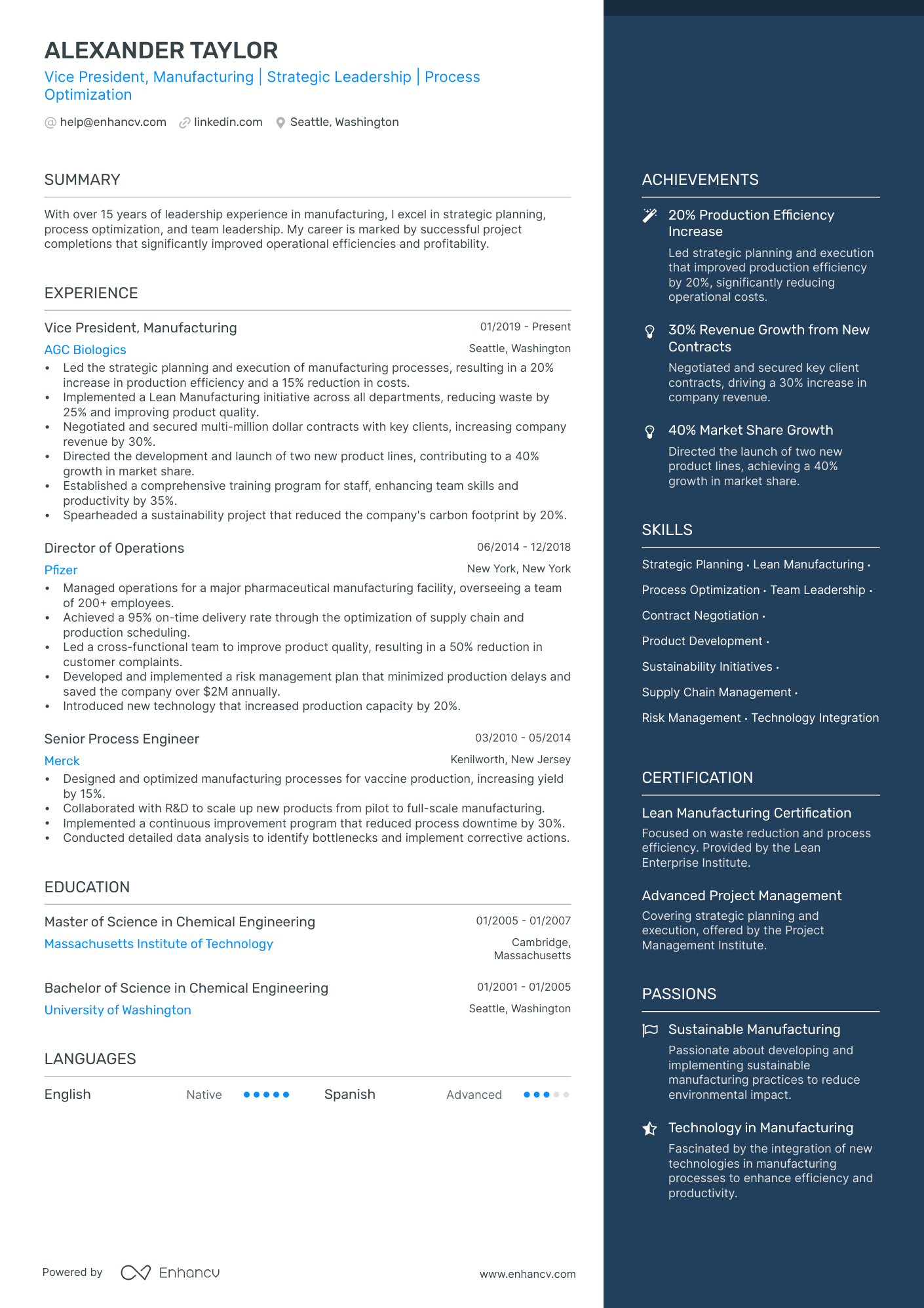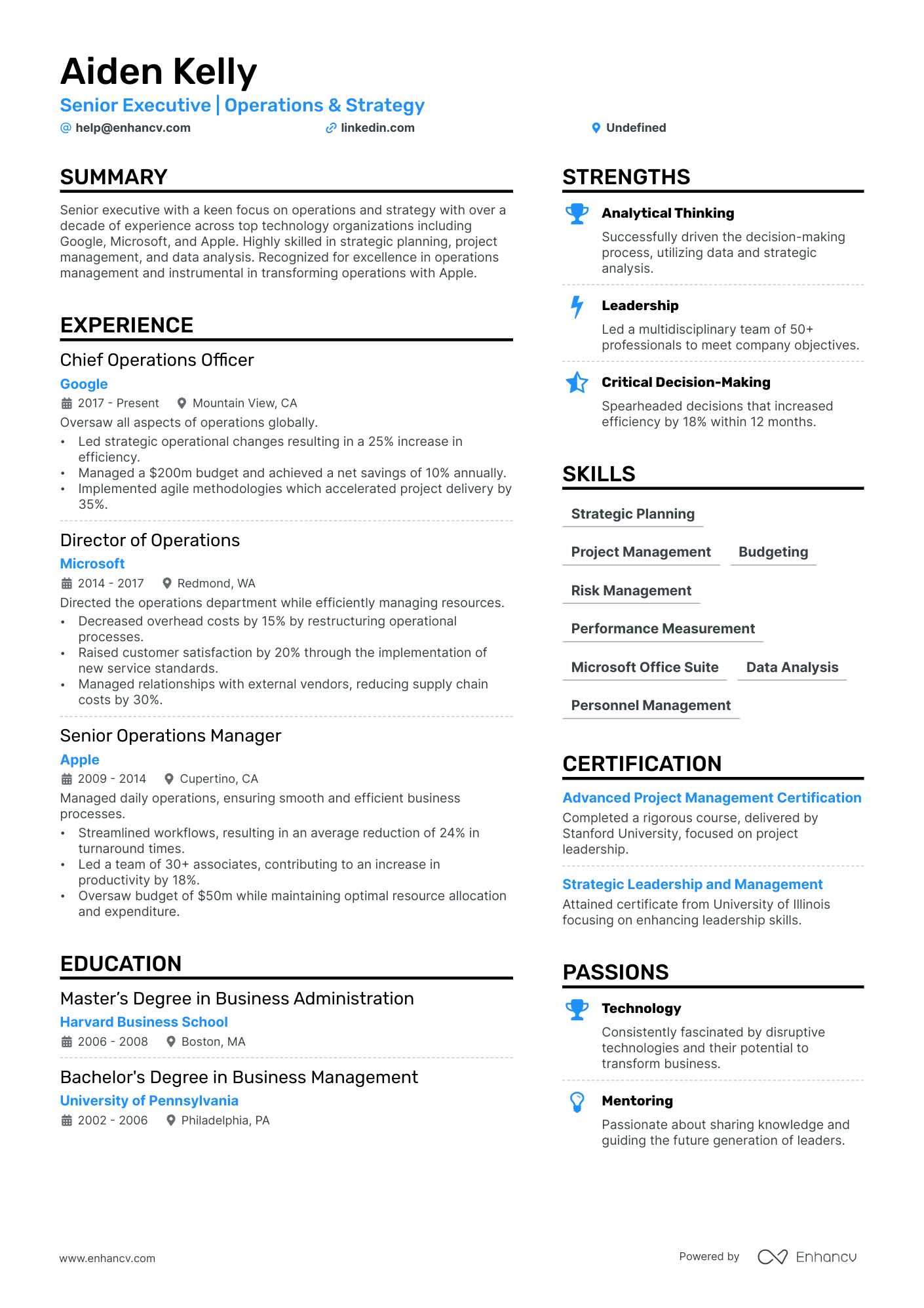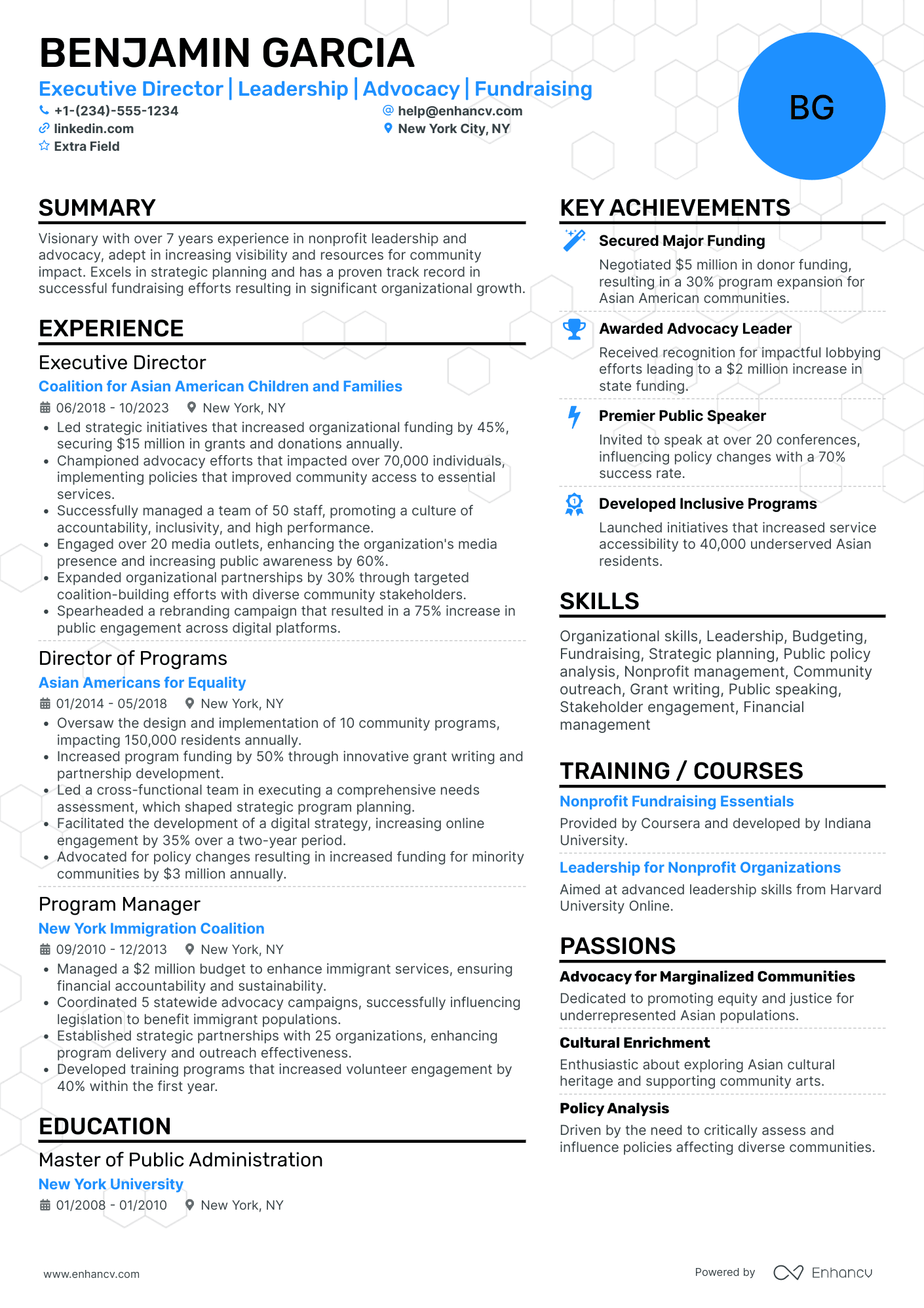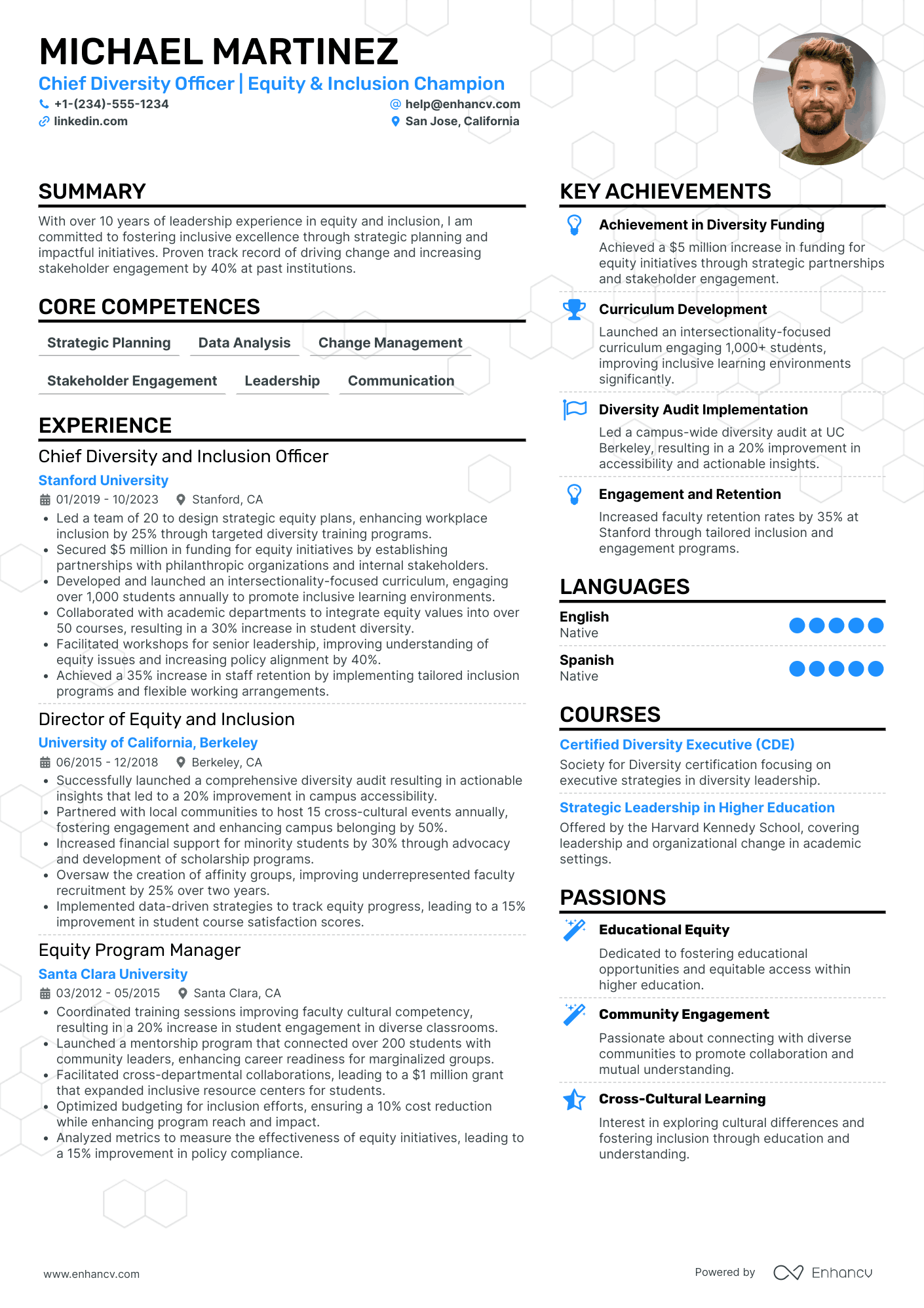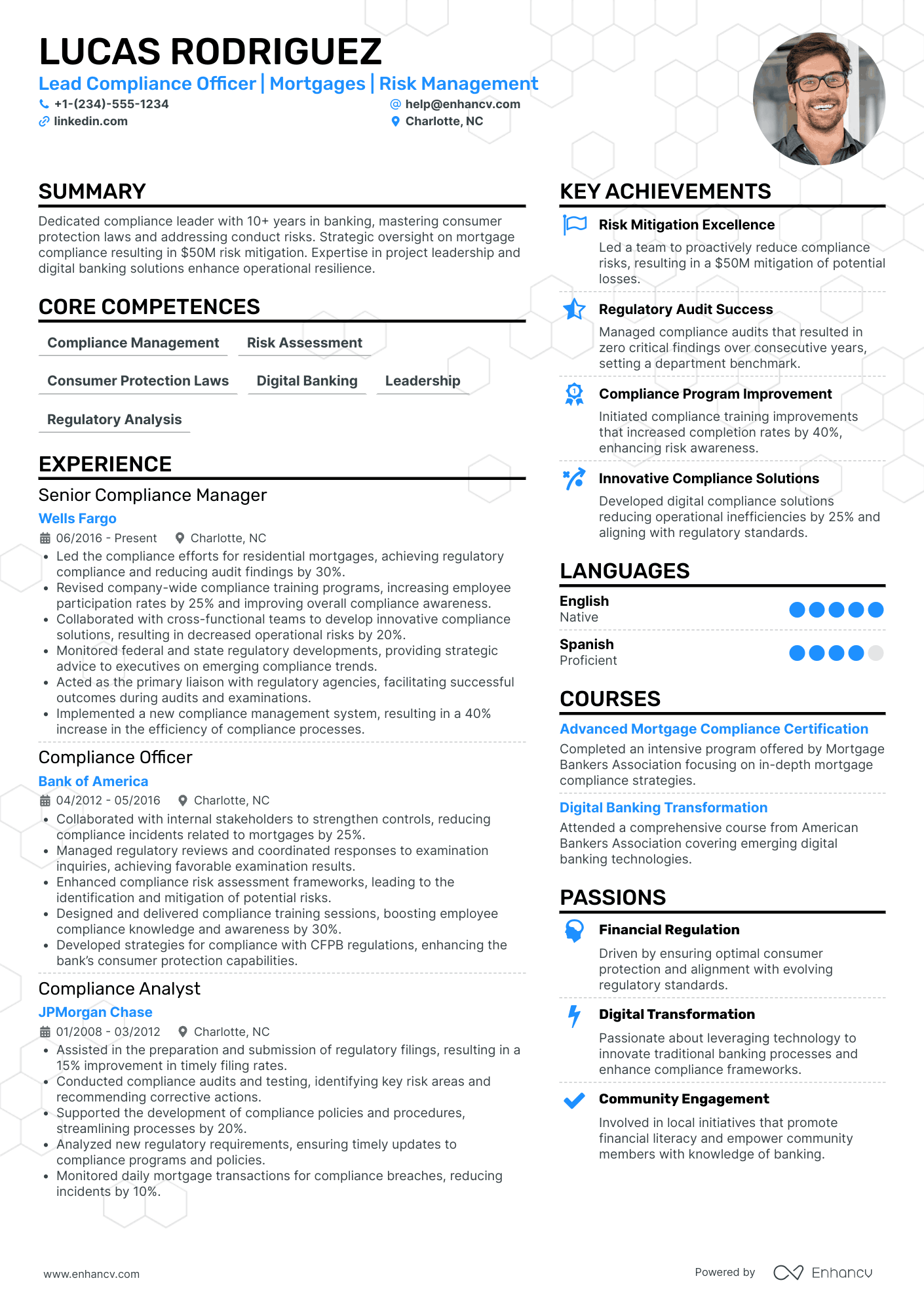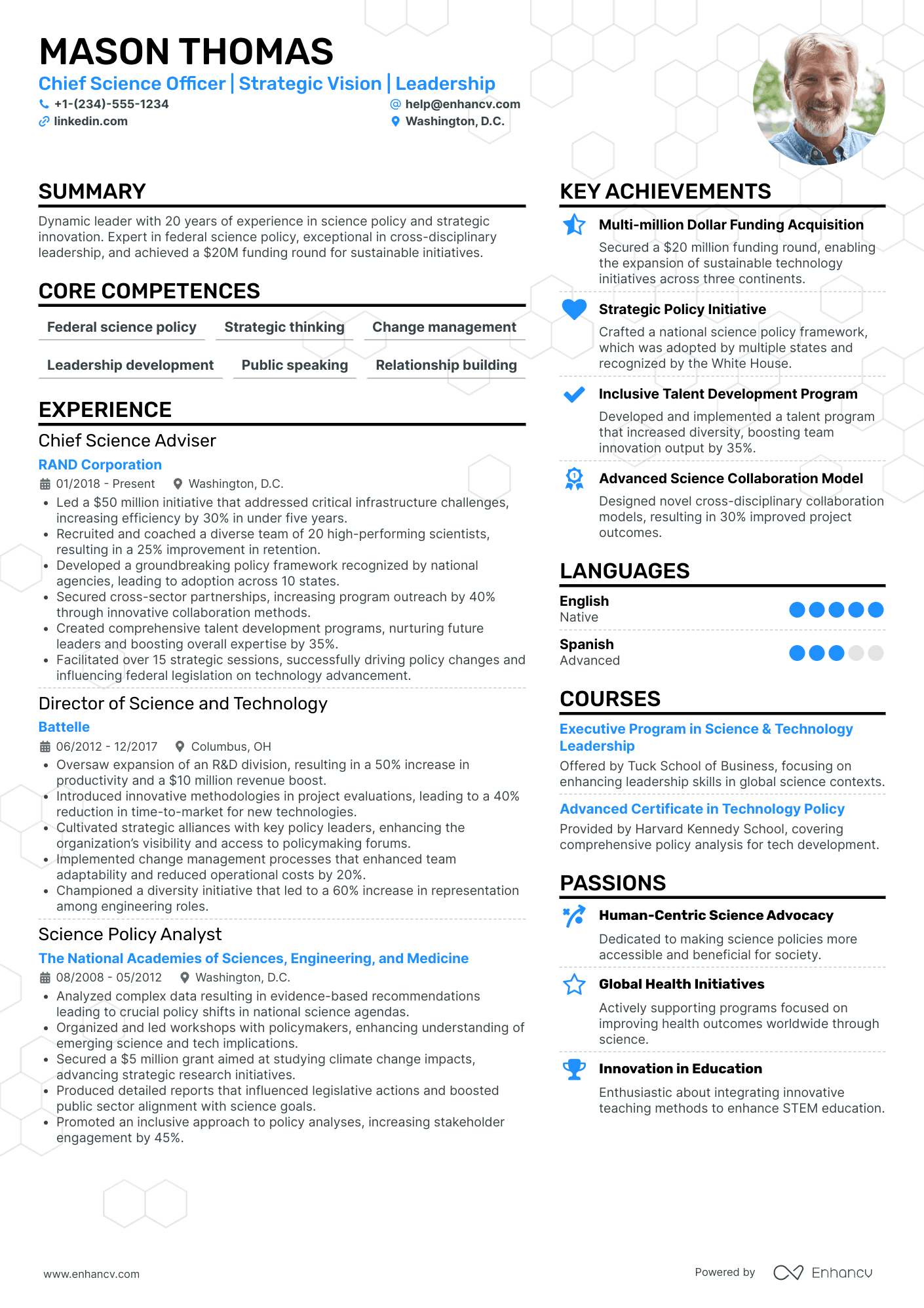So you want an executive resume that sets you apart.
But things changed in a big way. All the talk now is about these robo-scanning systems that won't even register resumes that don't fit their obscure guidelines.
And once you submit your executive resume, it will be reviewed by an army of recruiters who are relentlessly looking for the right combination of skill, achievement, and experience.
The next person it gets forwarded to is a member of a search committee who won’t bother reviewing it twice.
Somehow your executive resume has to work on all three levels.
Bad news is that it's tough. Good news is that it’s possible.
This guide will show you:
- Executive resume example that gets high-profile interviews 9 out of 10 times.
- What specific things recruiters want to see in your executive resume and how to use that to your advantage
- How to convey your excellent leadership and visionary skills on a piece of paper (i.e. how to make your resume speak)
- How to make sure your executive resume stands out while passing automated resume scanning systems in 2025
Looking for a specific C-Level resume?
- CIO Resume
- CMO Resume
- CFO Resume
- Marissa Mayer Resume
- VP of Sales Resume
- VP of Business Development Resume
- VP of Marketing Resume
How to write an executive resume to land more interviews
Writing an executive resume doesn’t follow your typical resume writing process.
Your executive resume should not be about simply listing previous jobs and skills — companies are looking beyond that in their future executives.
You are their next leader, and your executive resume should achieve at least three key objectives:
Demonstrate tangible impact.
Bragging with years of experience as a C-level manager won’t impress anyone. Your resume should demonstrate the real impact of your work, as recruiters won’t be looking for someone who simply adjusts to their environment. They’re looking for someone who can lead and change things for the better. Bad example: Managed a team of 30 engineers. Good example: Coordinated the work of more than 30 engineers in the development, testing, and production phases of a $10M project in the aero composite niche. More examples and tips in the Experience section. Hint: use resume action verbs to captivate recruiters and form the best first impression.
Convey a strong personal brand with unique differentiators.
Your resume is not just a marketing tool — it's a storytelling device. If you want to increase the chances of landing a job tenfold, align your personal story with the company's brand. Executives are too often a part of their company’s brand.
Are you tech-savvy genius with exceptional instincts for trends? A roll-up-the-sleeves guy on the frontline? Make sure your personal brand aligns well with the company brand.
Here’s how to establish a career-winning personal brand in your executive resume:
- Identify key accomplishments and skill scenarios in the top-third of your resume
- Include industry-unique resume keywords to build relevance and authority
- Differentiate yourself from other candidates by showing off your unique differentiators.
More details on how to do that in later sections.
Provide consistent excellence throughout the entire recruitment process.
The process of hiring someone for an executive role involves multiple interviews and stages.At every stage your executive resume will be read by several people for the first time. That means your resume should not be a one-time wonder — it has to consistently WIN on every level: during automated ATS resume scans, manual checks by a hiring manager, and elaborate analysis by C-suite stakeholders.
Here’s how to turn your executive resume into a golden ticket on every stage:
- Format, format, format. With a clever use of white space, layout, color, font, bold text, and headers, you can make your resume extremely attractive for both humans and robots.
- Use snippets of your resume to enhance your social profiles. Create consistency across various recruitment channels (LinkedIn, personal website, professional profile) to become memorable and project a consistent message.
- Don’t fall for a one-page resume myth. Entry-level candidates should have a one-page resume. Tech professionals can have a one-page resume. But executives with 15+ and 20+ years of excellence, industry awards, authority publications, and hard-won leadership skills? It's possible, but not applicable in every case. Even though we are strong advocates of the “more with less” approach, you won’t benefit from cutting out your best resume bits simply because you heard that one-page resume is good for someone.
The executive resume guide helps you write one that gets approved by both robotic ATS systems and human recruiters. We'll examine key areas of your resume to make sure it stands out and aligns with the company you're applying for.
Here are the sections that your executive resume will include:
The 6 most important sections of your resume
- A properly formatted header
- A concise and impactful summary
- An experience section tailored to the specific job
- Custom sections based on your experience
- Education & certificates sections
What recruiters want to see in your resume
- Are you a good leader with all the necessary skills for the job?
- Is your position consistent and strong throughout your whole resume?
- Are you a good fit not only in the short-term perspective, but also for the years to come?
- Do you have a solid personal brand and how well does it align with the company’s?
- Can you make an impact, and is there any evidence that you're capable of leading for success?
Your executive resume starts with a header. Let’s make sure it’s properly formatted and doesn't turn recruiters away.
Resume header: make sure recruiters keep reading
We’ll start with the obvious: there are many executive roles in a company.
You have CEO (chief executive officer), COO (chief operating officers), CTO (chief technical officer), CIO, CISO, CSO, and the list goes on.
And yes, there’s a lot of overlapping responsibilities between these jobs. A CIO in one company sometimes can transition to COO/CTO in another.
Despite that, it’s extremely important to use the same title in Header that the job you’re applying for uses, because COO and CIO in the same company do absolutely different things.
You must avoid using more than one title, even if you were working under both titles at one point in your career. This sends mixed signals to recruiters.
It goes without saying that your Header should include your contact details, but many applicants only give their phone number and email address.
Today almost every recruiter checks your LinkedIn profile along with your resume. Include the link to your profile in a header to control the narrative. A well-crafted LinkedIn profile with many connections makes you appear more credible and trustworthy. Check your executive resume and LinkedIn profile to make sure the work history is cohesive. Also, enhance your LinkedIn profile with some bits from your resume to ensure consistency.
If you don't have a developed LinkedIn profile, don’t link to an empty one. It’s better to link to your personal portfolio website or active membership profile in an authoritative, industry-specific network.
Point is, the link should work for you, not against you. But we strongly recommend to start working on your LinkedIn profile ASAP.
Here’s an example of a header that doesn’t work well:
2 executive resume header examples
Here we’ll include link to a Linkedin social profile, as well as use only one title that the job description mentions:
Check out our guide on perfecting your resume header with industry-leading examples!
Now let's engage recruiters even further with an impactful Summary section.
Resume summary: instantly stand out at every stage
The Summary section can have an incredibly powerful effect on your resume, but it works both ways.
If your Summary section is short, engaging, and relevant to the position, it will engage recruiters and create a lasting positive effect on how they perceive the rest of your resume. Think of the Halo effect.
If your Summary section is long, tedious, and full of fluff, recruiters might not even bother reading further. A major benefit of the Summary section is that you can easily adjust it to every position that you’re applying for once you get the basics of writing it.
Here are some tips to make your executive Summary section stand out and create a good momentum with recruiters:
- Keep it short. Two or three sentences should be enough to grab someone’s attention. If you’re going beyond that, either rephrase or use other sections to provide more details, e.g. Achievements or Experience sections.
- Keep it relevant. This is going to be recurring advice, but learn as much as possible about the company you’re applying for before writing a resume. What are their values? Are they growing? Are they in crisis?Summary is the first section where your research pays off. If you think the company needs a crisis manager, mention how you were able to transform a struggling business.If the company is a promising startup or a rapidly expanding network, make sure to mention your experience of scaling businesses and navigating a fluid business environment. Mention industry-specific experience relevant to the job to get some bonus points.
- Keep it impactful. Don’t simply brag about your qualities. Provide results and achievements. Instead of writing how you spent 10 years in marketing or corporate leadership, share what the company was able to achieve with your guidance.
Here’s an example of a tedious, self-centered Summary section that makes employers and hiring managers roll their eyes:
Optimize your resume summary and objective for ATS
Drop your resume here or choose a file.
PDF & DOCX only. Max 2MB file size.
2 executive resume summary examples
And here is an example of an engaging summary section to persuade readers to read further:
If you’re applying for another executive position, for example Chief Marketing Officer, follow the aforementioned advice but adjust it to the exact responsibilities of your future role.
Below is an example:
Want to learn more about crafting unique and engaging Summary sections? Check out our Perfect Summary guide with 30+ industry-specific examples.
We’ll now move forward to the bread-and-butter of your executive resume, the Experience section.
Resume experience section: maximum efficiency word for word
The Experience section is the most elaborate and extensive section of your executive resume, and recruiters will be returning to it several times throughout the whole recruitment process.
At first they’ll skim through it to understand whether you have a relevant experience, and leadership skills. This is where the most candidates will be filtered out.
During the next phase they will check whether your resume contains specific results and workflows that led you to achieving those results. They’ll be asking themselves: is this someone we need right now?
During the final round of checks, they’ll be comparing it with other candidates and see if you’re a good fit not only in the short perspective, but for years to come.
It doesn’t help that the Experience section is one of the hardest to write because executives have to squeeze in decades of experience in just one page, and make sure there’s still a place left for other impactful sections.
Let’s talk about what you need to include in your Experience section to get more calls, and what better should be left out of it.
Everything you mention in your executive resume experience section falls into three main categories:
- Results
- Workflows
- Buzzwords (resume keywords)
Results are the most impactful component of your experience section. Your achievements should be quantified, otherwise it’s just a string of words. Use numbers for more impact. Bad example: increased company’s presence on the education CRM market
Good example: over 3 years grew revenue in educational and mortgage segments by 300%
Pro tip
It’s important what kind of results you prioritise. Carefully study job requirements to understand what are the current company goals. Is it cost-efficiency? Workplace innovation? Or a new product launch? Prioritise results that are more relevant.
Workflows are what you did to achieve the results, or circumstances. Those are a perfect opportunity to hint at your core qualifications.
Workflows will reveal your subject matter experience, leadership and strategic qualities, and core competence in driving financial and operational results. You should describe workflows as challenges that you overcome. Use these questions to help to uncover some gems:
How did you contribute to the success of a company in a way that others didn't or wouldn't? What did you do that made the company better, more profitable, more efficient, and more competitive? How did your work benefit your coworkers and clients? What ideas of yours changed the course of events? Again, carefully study job requirements to understand which workflows will play a bigger role. No two companies are the same, so executives’ responsibilities will vary based on the company's size, industry, structure, and culture.
Buzzwords, or resume keywords, are largely defined by trends in every industry, and you can use them to quickly bring your resume up to date and target companies that are looking for very specific competencies.
Examples of buzzwords per industry: distance learning in education, crisis management in travel industry, managing distributed teams in real estate, machine learning and agile practices in IT, and so on.
Don’t overuse trendy words though, and especially don’t insert them blindly just to impress executive recruiters. Use only those skills that you have hands-on experience with.
Again, study job requirements to understand what kind of buzzwords may play into your hands.
For the best results, combine results, workflows, and buzzwords. Study job description and put more relevant workflows on top.
Here’s an example of vague experience section which is more focused on circumstances of work rather than results:
executive resume experience examples
- •Established and built relationships with top leaders in the market
- •Directed and oversaw financial and budgetary activities
- •Direct the company in keeping with the vision outlined for the company by the Board of Directors
Here’s an experience section optimized for impact with relevant results and comprehensive workflows:
- •Established and built relationships with top leaders in the market, including those representing the highest levels in business, government and non-profit sectors, growing export revenue by 300%
- •Ensured coordination and alignment of all company activities to strategic direction in the areas of resource development and staff alignment, reducing department costs by 25% two years consecutively
- •Planned, organized, directed, and evaluated labor and administrative policies and operations that brought company from state leaders to country leaders.
Here’s an example of how the Experience section might look if you’re applying for a CTO position.
Notice that it contains more buzzwords and technical terms that were revealed after studying the company background and its key products:
- •Established, communicated, and developed a clear action plan for the new vision of Technology Department, reducing $4M annually on operating expenses
- •Facilitated in planning and release of 4 strategic company products that led to 23% increased ML-based CRM solutions market share
- •Increased client satisfaction on a company-wide level by 400% after implementing a set of advanced real-time reporting system for monitoring support staff performance
Pro tip
Beware of “death by bullets”, or using more than five bullet points in a row when describing your experience, otherwise your resume becomes unreadable. If you have too many bullet points, consider rewriting the section or adding short paragraphs of text in between.
C-level skill section: what recruiters really like to see here
Every executive role involves a wide range of skills. Add to that 15 years of experience on average and every executive can easily fill up a blank page simply listing all the skills they possess.
Don’t fall into this trap. No one will be reading that much. And the impact behind every skill will be diminished by the sheer amount of them.
The best thing you every candidate for an executive role can do is to prioritise skills that are needed the most for a given job, and then group those skills into broader categories.
Bad example: high performance under stress, predictive planning, negotiation, monitoring, critical thinking, etc.
Replace with: Crisis Management: Preserved company’s market share and net profit during the outbreak while the average competitor lost 10-20% of their income.
After you narrow down the most important skill categories, make sure to put those into context, because this is the most convincing way to demonstrate that you really have them.
For most executive roles, apart from Chief Technology officer, soft skills are a priority, so list them first.
Here’s an example how to list soft skills on your executive resume:
How to describe soft skills on your resume
Below are some skills that you can group in your Skill section:
Soft skills list for C-suite resumes
- Leadership
- Communication
- Strategic management
- Strategic partnerships
- Resource development
- Analytical approach
- Financial management
- Presentation skills
- Marketing
- Revenue Growth
- Coordination
- Active listening
- Time management
- Problem solving
- Strategic planning
- Coaching
- Innovative thinking
- Reporting
- Quality control
- Lean/Growth mindset
- Collaboration
- Risk management
- Evaluation
- Process organization
- Policy development
What you need to know about hard skills
The amount of technical skills you need to mention in your resume will largely depend on the specific role.
Chief innovation officer, chief technical officer and chief information officer are expected to be more tech savvy than other executive positions, so listing some key technical skills would be of help.
Same goes for any executive role in IT-related companies vs other industries.
But mostly try to focus on your management skills and achievements associated with them.
Resume education section: do you need it?
Although experience is deemed far more important than education history for any executive position, you’ll rarely find a job that doesn’t require at least a bachelor's degree.
Education requirements vary from job to job. Some companies require a Master's degree in business or related field.
If you don’t have a relevant degree it might be substituted with an advanced business training, such as MBA. Make sure to put it before other information on education in your resume.
Resume certificates: which ones are the best
Certificates aren’t a decisive factor for an executive resume, but they can strengthen your overall profile.
Note that chief technology officer and chief operations officer will have a different portfolio of certificates, although there are general leadership certificates that any executive resume can benefit from.
Below are some examples:
Top 5 executive certificates for your resume
- Harvard Kennedy School executive Certificates
- Harvard Business School Certificate of Management Excellence
- MIT executive Certificate
- Cornell University executive Leadership
- Michigan State University’s Business Leadership and Management
How to write a senior executive resume?
- Target your resume to the position. It’s imperative that you tailor your executive resume to the position and the company that hires you. Don’t just demonstrate that you have the needed skills. Use the Experience and Summary section to demonstrate that you overcame challenges similar to what they experience right now. Often companies switch leadership in time of crisis and uncertainty. Learn more about the target company’s recent challenges and use this information to build authority and relevance.
- Make the most impact with the top-third of your resume. Your senior executive resume is going to be long, but to make sure people will read all of it you need to give them a motivation. Use the top third section to present your key achievements and skills.
- Maximise the impact of your third page. There’s no need to describe all the jobs you had over the span of a 20 or 30+ year career. This will certainly eat all the pages on your senior executive resume. Instead, use the last page of your resume to showcase your unique identifiers and set yourself apart: list awards, publications you were featured in, research projects, and lifetime accomplishments.
Having problems packing all your years of experience in a resume? Check out our guide on resume length.
Additional sections to boost your resume special sauce
Your executive resume provides impact and demonstrates that you have all the necessary skills to be successful in your work.
It’s time to stand out of your competition and leave a lasting impression with custom sections.
Here are some custom sections that you can use to highlights your leadership skills and build your personal brand even further:
Achievements / Highlights
Every executive with many years of experience undoubtedly had career highlights that deserve attention.
It’s important to keep this section focused on specific achievements and not just brag about yourself.
Those achievements may include: prestigious business awards, work achievements, and even published books relevant to the job.
Our selected resume template above is from one of our successful clients, William H. Saito, who used custom sections to build a strong personal brand and hint at holistic development of his leadership skills.
Day of My Life
If you feel creative and confident in the rest of your resume, you can provide a personal touch with a “Day of My Life” section. This section is extremely powerful as it can help you demonstrate your human side and integrity.
Coupled with your achievements and work results from other sections, this is a great way to show your ability at following work and life balance, balance priorities, and sustain integrity.
A great example of this section in use is our Marissa Mayer’s resume which not only went viral and got a great number of positive responses, but also attracted attention from leaders of a business world, such as Mark Cuban.
Key takeaways
- Approach resume writing process not only for marketing, but also for building your personal brand and forming unique selling proposition;
- Make sure the brand you build aligns well with the company that you want to work with;
- Strive to demonstrate impact with every section of your executive resume using results, achievements, and confident language;
- Stand out from the crowd of other candidates with custom sections that drive your personal brand even further and demonstrate you as all-round person;
- Make sure to study the job requirements and the company’s history before applying as it will help you make your resume much more aligned with their vision of who will lead their company.
Executive resume examples
By Experience
Executive Vice President of Finance
Executive Vice President of Marketing
Executive Vice President of Sales
Executive Vice President of Operations
Chief Executive Officer (CEO)
Executive Vice President of Product Development
Executive Vice President of Business Development
By Role
Alliance Manager
CCO
Chief Executive Officer
Chief Financial Officer
Chief of Staff
CIO
CTO
Department Head
Department Manager
Executive Director
Executive Manager
Fractional CEO
Functional Manager
Management
Vice President
Board of Directors
Executive Director of Engineering
Executive Director of Nonprofit Organization
Executive Director of Human Resources
Executive Director of Information Technology
Chief Integrity Officer
- Clear and Structured Presentation - Amelia Miller's resume is well-organized and concise, ensuring clarity in the presentation of her professional journey. The use of precise bullet points and distinct sections enables a quick overview of her qualifications, skills, and achievements, making it easy for potential employers to identify her strengths.
- Impressive Career Trajectory - The resume highlights Amelia's progressive growth within the law enforcement field. Her transition from a Police Officer to a Senior Investigative Officer reflects both her capability and dedication to advancing her career, showcasing her drive and leadership potential.
- Technical Depth in Law Enforcement - The resume emphasizes Amelia's adeptness with industry-specific tools and methodologies. By integrating advanced surveillance technology and collaborating on software development, she demonstrates her ability to leverage technical solutions to enhance investigative operations, setting her apart in the field.
Chief Data Officer
- Structured and well-organized presentation - The resume is neatly divided into sections, each conveying distinct aspects of the candidate's professional profile. The clarity in layout demonstrates a strategic approach to showcasing key accomplishments, skills, and experiences effectively, aiding quick comprehension for recruiters.
- Progressive career trajectory in healthcare and analytics - Jack Allen's career path shows significant upward mobility within the healthcare industry, transitioning from a Clinical Research Specialist to a Chief Data and Analytics Officer. This growth highlights his capacity to excel in complex roles, drive technological advancements, and take on increasing leadership responsibilities.
- Innovative data solutions and impact-driven results - The resume is rich with industry-specific examples of Jack pioneering predictive analytics, integrating IoT technology, and launching machine learning initiatives. Each achievement is tied to substantial business impacts, such as cost reductions, enhanced patient outcomes, and improved operational efficiencies, which underscore his technical depth and strategic mindset.
Chief Digital Officer
- Clear and Structured Content Presentation - The resume is expertly organized, with sections that make it easy to locate critical information quickly. Each section is concise yet comprehensive, providing a clear picture of the candidate’s qualifications. The use of bullet points in the experience section effectively highlights key achievements and contributions without overwhelming the reader.
- Consistent Career Growth and Strategic Leadership - Liam Johnson's career trajectory demonstrates a steady rise through significant roles in the genetic testing and healthcare industries. The progression from Director of IT to Chief Digital Officer reflects an upward career movement driven by skill enhancement, leadership capabilities, and a focus on driving digital transformation within organizations.
- Industry-Specific Expertise and Technical Impact - The candidate showcases deep industry expertise by detailing accomplishments in AI, ML, and LIMS optimization, critical areas for innovation in genetic testing. By integrating AI and ML into genetic testing workflows, they improved accuracy by 50%, underscoring their technical proficiency and understanding of industry-specific tools essential for the role.
Chief Revenue Officer
- Structured and Clear Presentation - The resume is well-organized, following a clear structure that makes it easy to digest. Sections are distinctly marked, allowing the reader to navigate through professional experiences, education, skills, and achievements efficiently. This clarity ensures that key information is quickly accessible, enhancing readability.
- Impressive Career Trajectory and Growth - James Jones demonstrates a robust career progression with increasingly significant roles in major nonprofit organizations. The transition from a Senior Manager to Chief Revenue Officer exemplifies his career growth and leadership ascension, emphasizing his ability to handle greater responsibilities and contribute to larger organizational goals.
- Relevance of Achievements to Nonprofit Leadership - The listed achievements go beyond mere numbers and underline their direct relevance to nonprofit leadership. His ability to secure substantial funding through diverse channels and develop corporate partnerships aligns perfectly with the strategic objectives of a Chief Revenue Officer, showing his capacity to drive organizational impact and sustainability.
Chief Diversity Officer
- Comprehensive Presentation and Clarity - The resume is structured in a manner that emphasizes clarity and conciseness, with well-organized sections that present information logically. This allows for easy navigation and ensures that key accomplishments and skills stand out to a hiring manager, aligning perfectly with Michael’s advanced role in diversity and inclusion.
- Strategic Career Progression - Michael’s career trajectory demonstrates a clear path of growth through increasingly responsible positions within prominent academic institutions. From an Equity Program Manager to a Chief Officer, this upward mobility highlights a consistent expansion of influence and responsibility, reflecting mastery in leadership and diversity domains.
- Innovative Diversity Initiatives and Impact - The resume details industry-specific methodologies such as creating intersectionality-focused curriculums and conducting comprehensive diversity audits. These initiatives are not only sector-appropriate but also demonstrate tangible impact, including enhanced workplace inclusion, thus underlining Michael's ability to effect meaningful change in academic environments.
Chief Compliance Officer
- Clear and Structured Presentation - The resume is logically structured, presenting information clearly across various sections such as education, experience, skills, and achievements. This organization ensures that the reader can easily follow Lucas Rodriguez's career path and skill set, which are critical in highlighting his relevance for a compliance leadership role.
- Robust Career Growth in Compliance - Lucas Rodriguez's career trajectory showcases a consistent climb within the banking industry, from Compliance Analyst to Lead Compliance Officer. This upward mobility demonstrates not only his dedication and competence in compliance but also his capacity to handle increased responsibilities and lead major compliance initiatives successfully.
- Achievements with Significant Business Impact - The resume prominently features Lucas's impactful achievements, such as leading a $50M risk mitigation effort and achieving a 30% reduction in audit findings. These highlights not only provide quantifiable evidence of his skill but also underscore his ability to contribute to organizational success and financial security through effective compliance management.
Chief Risk Officer
- Logical presentation of content - The resume stands out with its clear and structured format, making it easy to navigate. Each section is well-organized, starting with a succinct summary, followed by detailed experiences, and culminating with education and additional qualifications. This clarity and conciseness ensure that the key highlights of Ella's career are readily accessible to readers.
- Strategic career growth in risk management - Ella's career trajectory is marked by significant upward mobility, starting as a Risk Analyst and progressing to the role of Chief Risk Officer. This progression not only highlights her dedication and capacity to evolve within her industry but also demonstrates her ability to take on greater responsibilities, adapting to new challenges and opportunities in risk management.
- Impactful achievements with business significance - The resume includes specific, quantifiable accomplishments that underline Ella's contributions to her organizations. Notable achievements, such as reducing insurance costs by 20% and improving operational efficiency by 40%, are presented with their direct impact on the business, demonstrating her practical value in achieving organizational objectives.
Chief Networking Officer
- Career Advancement with Consistent Industry Focus - The resume demonstrates a clear career trajectory, with Victoria Baker moving from Network Engineer to Senior Network Engineer. This progression highlights her growth and increasing responsibilities within the network engineering field, maintaining a focus on network security and infrastructure design, which adds depth to her expertise.
- Strong Leadership and Cross-Functional Collaboration - Victoria's ability to lead and work across different functions is evident in her role at Cisco Systems, where she led a team to enhance network architecture and drove cross-functional projects. This emphasis on leadership and collaboration underscores her capability to manage teams and work with diverse groups to implement effective network solutions.
- Impactful Achievements with Business Relevance - The resume lists key achievements that go beyond numbers, demonstrating their substantial business impact. For instance, projects that increased system reliability and reduced operational costs by significant percentages show her ability to enhance company performance and efficiency, thus directly contributing to business success.
Chief Development Officer
- Structured and Focused Presentation - The resume effectively utilizes distinct sections to organize information, allowing for ease of reading and comprehension. Each section presents targeted information concisely, aiding in a streamlined reading experience that highlights key accomplishments, skills, and career progression relevant to the role of a Chief Development Officer.
- Diverse Career Trajectory - Benjamin's career path demonstrates a clear upward trajectory in the nonprofit sector, showcasing several promotions and an expansion of responsibilities. His roles have evolved from Development Director to Vice President of Development, ultimately reaching the position of Chief Development Officer, indicating his growth in leadership and influence over time.
- Emphasis on Innovative Fundraising Techniques - The resume extensively covers the use of cutting-edge tools and methodologies, such as leveraging Salesforce CRM for donor database management and implementing data-driven campaigns. These elements underline the candidate’s modern approach to fundraising, emphasizing technical depth and innovative strategies that enhance donor engagement and retention.
Chief Communications Officer
- Clarity and Structure in Presentation - This resume is notable for its clarity and well-organized format. Key sections such as experience, skills, and education are distinct and easy to follow. The use of bullet points for responsibilities and achievements helps in presenting information concisely and accessibly, making it easier for a potential employer to quickly grasp the scope and depth of Victoria's experiences and capabilities.
- Dynamic Career Progression - Victoria's career trajectory is impressive, demonstrating significant growth and increased responsibility over time. She progressed from Director of Development at the World Health Organization to Senior Vice President roles at influential organizations like CARE USA and Doctors Without Borders. This advancement reflects her ability to take on more complex challenges and lead increasingly larger teams, underlining her strategic acumen and leadership qualities.
- Impactful Achievements with Strategic Relevance - The resume effectively highlights not just impressive numbers, but the strategic impact of Victoria's accomplishments. For instance, initiatives leading to substantial increases in donations and donor retention showcase her ability to leverage strategic partnerships and innovative fundraising techniques. These achievements not only demonstrate her effectiveness but also illustrate a strong alignment with business goals, such as enhancing global health funding and engaging broader donor demographics.
Chief Analytics Officer
- Dynamic Career Progression - The career trajectory of Lucas Rodriguez highlights a robust progression from Senior Data Scientist to Chief Data and Analytics Officer. His record shows a consistent upward climb, marked by roles of increasing responsibility at major corporations like IBM and Pfizer, reflecting his growing influence and expertise in the field of data analytics and healthcare.
- Impactful Achievements - Lucas's resume effectively underscores significant business relevance through his achievements. By highlighting key accomplishments like contributing to $5 million in cost savings and implementing strategies that increased patient treatment efficiency by 25%, it illustrates his ability to deliver valuable outcomes and strategic improvements in data processes and patient care.
- Comprehensive Skill Set Highlighted - This resume encapsulates a blend of industry-specific technical skills alongside leadership capabilities. By emphasizing competencies in AI, machine learning, clinical research, and data governance, along with strategic thinking and cross-functional team leadership, it presents a comprehensive skill set that is particularly pertinent to an executive role focused on leveraging data for healthcare analytics.
Chief Growth Officer
- Clear and Structured Presentation - The resume is well-organized, featuring distinct sections such as experience, education, skills, and achievements. Each section is concise and structured to enhance clarity, making it easy for readers to follow Scarlett Anderson’s career story and notable accomplishments without distraction.
- Strategic Career Growth and Leadership - Scarlett’s career trajectory showcases a consistent upward movement in strategic leadership roles within the industry. Her growth from a Real Estate Manager to Chief Growth Officer demonstrates her capability to take on greater responsibilities, navigate complex business environments, and drive strategic initiatives.
- Achieving Impact through Measurable Successes - The resume goes beyond listing responsibilities to detail the tangible impacts Scarlett has made, such as achieving 30% revenue growth through M&A and saving $2 million annually in real estate expenses. These achievements reflect her ability to align strategic goals with business outcomes, contributing significantly to organizational growth.
Chief Innovation Officer
- Clear and Concise Presentation - This resume stands out for its structured and straightforward format, ensuring clarity and ease of reading. Each section is neatly organized, and bullet points are used effectively to highlight key achievements and responsibilities, making it easy to digest complex information quickly.
- Progressive Career Trajectory - Zoey Walker's career progression is a testament to her leadership and expertise in the medical device field. She has steadily advanced from a Senior Innovation Manager to a Chief Innovation Officer, reflecting her capability to adapt and thrive in leadership roles across different high-impact companies such as Boston Scientific, Stryker, and Medtronic.
- Significant Achievements with Industry Impact - The resume emphasizes achievements that are not just numerical but highlight meaningful business impact. For instance, spearheading initiatives that result in a 30% increase in R&D product launches or a $2M annual saving showcases her ability to drive innovation and efficiency, delivering tangible value to her organizations.
Chief Sustainability Officer
- Impressive Leadership and Team Management - Leah Torres demonstrates a strong capacity for leading teams, as shown by her experience overseeing an 8-person team at Johnson Controls and directing statewide initiatives at Siemens. Her leadership is further highlighted by achievements like implementing training programs and fostering interdepartmental collaboration, all contributing to a robust culture of sustainability and innovation.
- Significant Achievements with Business Impact - The resume effectively emphasizes significant achievements that make a difference within the business context. By spearheading energy-saving initiatives that resulted in over $2 million in cost savings and securing $1.5 million in funding through successful grant proposals, Leah clearly shows her ability to drive financial outcomes while meeting sustainability goals.
- Deep Industry-Specific Expertise - Leah's resume showcases an extensive background in sustainability and energy management, highlighted by her role in integrating renewable energy sources with a 40% increase in usage. Her certifications, such as Certified Energy Manager, further underline her technical proficiency and commitment to advancing in her field, ensuring she remains at the forefront of industry developments.
Chief Experience Officer
- Structured Experience Descriptions - The resume offers a clear, concise outline of the candidate's career history, making it easy to follow their professional journey. Each position includes a series of bullet points highlighting key roles and achievements, effectively communicating the candidate’s contributions and impact across different companies.
- Notable Continuous Growth - Charlotte’s career trajectory demonstrates impressive growth within the product design field. Progressing from a UX Designer to a Senior Product Designer, her experience spans diverse environments, showcasing adaptability and an upward career trajectory filled with increasing responsibilities and leadership roles.
- Emphasis on Leadership and Collaboration - The resume effectively underscores Charlotte's leadership skills and her ability to collaborate within cross-functional teams. Her experience in leading design teams, training junior designers, and facilitating strategic planning sessions highlights her prowess in enhancing team productivity and aligning design goals with business objectives.
Chief Learning Officer
- Highly structured and effective presentation - The resume is logically organized with distinct sections for Summary, Experience, Education, Skills, Courses, Achievements, Languages, and Passions. This structure enhances clarity and allows for easy navigation, ensuring that key information is highlighted and accessible to the reader. Concise bullet points in each section succinctly convey significant details without overwhelming the reader.
- Impressive career trajectory demonstrating growth - The career history reflects a strong upward progression, advancing from an Online Program Coordinator to a Chief Learning Officer over a decade. Each role shows increased responsibilities, indicating a successful career in online education leadership. This trajectory showcases the candidate's ability to achieve promotions and adapt to new challenges while demonstrating leadership in the expanding online education sector.
- Strong cross-functional and strategic leadership - The resume highlights diverse skills and leadership experiences, including strategic planning, academic policy development, and digital transformation management. By fostering collaborations with industry leaders and managing budget allocations, the candidate illustrates their capability to lead, innovate, and drive initiatives that align with both academic standards and business goals within online education.
Chief Science Officer
- Clear and Structured Presentation - The resume is well-organized, beginning with a succinct summary that provides an overview of the candidate’s strengths in science policy and leadership. Each section is distinct and clearly labeled, making it easy to navigate and understand the career accomplishments and skills at a glance.
- Impressive Career Trajectory - Mason Thomas exhibits a progressive career path, moving from a Science Policy Analyst to a Chief Science Adviser. This advancement highlights sustained growth and a steady increase in responsibilities, reflecting a successful climb within the science policy and technology sectors.
- Rich in Leadership and Influence - The resume emphasizes strong leadership abilities, evidenced by roles that involved coaching teams, leading large initiatives, and driving policy changes. These positions underscore the candidate’s capabilities in not only managing technical projects but also guiding and mentoring talent to achieve strategic organizational goals.
Chief Legal Officer
- Concise and Structured Presentation - The resume is well-organized, utilizing a clear hierarchy with distinct sections for experience, education, and achievements. Each segment is concise, ensuring that the most pertinent information is readily accessible, which is crucial for retaining the attention of hiring managers.
- Diverse Career Trajectory with Leadership Emphasis - The candidate's career path illustrates a consistent upward trajectory, progressing from Senior Corporate Counsel to Chief Legal Officer. This progression underscores a strong capacity for leadership, and an ability to take on increased responsibilities across different companies, such as Nestlé USA, Unilever, and General Mills.
- Emphasis on Strategic Achievements - The resume highlights impactful achievements with significant business relevance, such as leading a $1.2 billion merger and negotiating global partnerships that increased annual revenue by $200 million. These accomplishments demonstrate the candidate's capability to drive strategic business growth and foster sustainable corporate progress.
Chief Analytics Officer
- Clear Structure and Flow - The resume is presented with a well-organized structure, making it easy to navigate and comprehend. Each section is distinctly labeled, offering a logical progression from the candidate's executive summary through experience, education, and skills, reflecting a coherent narrative of professional growth.
- Diverse Career Progression - Isabella Adams demonstrates a robust career trajectory, transitioning from clinical informatics to leadership roles in data analytics and AI. This showcases a significant evolution reflecting both vertical growth through promotions and lateral growth by expanding into broader strategic roles within the healthcare industry.
- Technological Expertise and Impact - The resume highlights specific tools and methodologies such as AI, machine learning, and cloud-based analytics solutions, underscoring the candidate’s technical depth. Isabella's technical proficiency is matched by her ability to make an impact, evidenced by achievements like improving data project success rates by 30% and reducing operational costs, demonstrating practical business relevance and innovation.
Chief Logistics Officer
- Conciseness in Presentation - The resume is structured in a concise manner, presenting Oliver Davis's extensive experience and accomplishments without unnecessary detail. Each section is clearly labeled and provides information directly relevant to the logistics field, making it easy to navigate and understand.
- Continuous Career Advancement - Oliver Davis's career trajectory illustrates a clear path of growth, progressing from a Logistics Supervisor to a Senior Logistics Coordinator. This upward mobility in notable companies such as Maersk Line and Hapag-Lloyd highlights his capability and success in the logistics industry.
- Innovative Safety and Compliance Leadership - A key aspect of Oliver's professional journey is his expertise in safety compliance and regulatory adherence. His achievements in reducing incident rates and improving compliance demonstrate strong leadership skills and a commitment to enhancing operational safety and efficiency in port operations.
Chief Procurement Officer
- Structured Clarity and Conciseness - The resume is meticulously organized with clear section headings, allowing easy navigation through the candidate’s extensive experience. Each position is accompanied by succinct bullet points that convey significant achievements, ensuring readability and efficient information delivery.
- Impressive Career Growth and Promotions - Mila Allen's career trajectory is a testament to her professional growth within the procurement industry, evidenced by progressive roles from Procurement Manager to Chief Procurement Officer. This advancement within reputable companies like Siemens and Honeywell highlights her capacity for leadership and adaptation to larger responsibilities.
- Demonstrations of Business Impact through Achievements - The resume convincingly showcases achievements that have substantial business impacts, such as saving millions in procurement initiatives and enhancing supplier performance. These accomplishments not only demonstrate her strategic capabilities but also her ability to contribute appreciably to an organization's financial health and operational efficiency.
Chief Security Officer
- Structured and Concise Presentation - The resume is well-organized, presenting Chloe Martinez's professional journey in a clear, concise manner. Each section is easy to navigate, and bullet points ensure that each point is succinct, making her achievements and experience readily accessible to readers.
- Impressive Career Growth and Leadership Development - Chloe's career trajectory shows admirable growth, moving from a Security Operations Manager to a Chief Security Officer. Each position highlights increasing levels of responsibility and showcases her evolution as a leader in security management and risk mitigation across prestigious healthcare institutions.
- Industry-Specific Innovations and Methodologies - Chloe demonstrates her technical depth and industry expertise through her pioneering efforts in implementing advanced surveillance tools and comprehensive security assessments. Her ability to integrate cutting-edge technologies within a healthcare environment emphasizes her forward-thinking approach and technical savvy.







